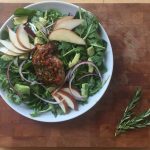To Say It or Write It, Or Not? That is the Question.
Back in 2005 when I first learned about the Paleo diet, and it proved to be what helped me heal from over two decades of GI distress, I wanted to tell everyone and anyone about it. And I did! It evolved overtime to become the focus of my career and in earlier days, I found it hard to suggest people cheat, or follow an 85% rule or any other permutation, for no other reason than I was so incredibly passionate about the simplicity and beauty of how eating real food, and not eating things we’re not meant to be eating, can allow us to heal our bodies. Over time, however, I noticed a few things. For one, being too dogmatic can be a put off for many. Not that I have changed my views; I still whole heatedly feel that we’d all benefit from being completely Paleo, but at the same time, many find heading there in stages is a better approach for them. And there’s nothing wrong with that! If you take the example of someone who eats a very low quality diet and never exercises, and their step one is to add some greens a few days per week, even though they’re still eating gluten, dairy and soy, and get them out and walking for 15 minutes a day, that is still heading in the right direction. Another thing, and this is less positive, is the amount of Paleo misconceptions that abound now. The idea that we can make a deliciously decadent treat out of honey, dates, ripe banana and raw cacao for a special occasion once in a while has spun into a plethora of making said treats, but relying on them as staples of a daily regime. That, coupled with the approach of going Paleo by recreating processed foodstuffs inherent to the Standard American Diet and working backwards, replacing white flour with almond flour, swapping Crisco for butter (neither of which are Paleo) and relying on thickeners from guar, xanthan and carrageenan gums for the end result of products that insert the word Paleo and then hop on the bandwagon to make a buck. While savvy from a business sense, it does nothing to help promote the Paleo approach. In the words of Dr. Loren Cordain, the idea of Paleo is to ‘mimic what our ancestors ate with foods that are readily available to us in our grocery stores, farmer’s markets and our own backyards’. So we don’t need to hunt and gather ourselves, although we certainly can, but at the same time, the idea is not to eat ‘Paleo-pancakes’, ‘Paleo bread’, ‘Paleo Brownies’ and”Paleo ice-cream’ on a regular basis. How often should we indulge? Let’s consider the beehives and honey example. Did cavemen gorge in honey every day? Not likley. Studies indicate they’d likely come across a beehive now and then and they likely would have gorged themselves, and then not had more until the next time they happened upon another hive. That’s how often we, too, should partake of these treats that, despite being gluten-free, soy-free and (sometimes, but not always) dairy-free, are still not in keeping with the whole idea of the Paleo regime. And this is why I beg the question above. There are times I don’t even want to use the word as it’s become so daunting to so many, and the more we perpetuate that it is another other than a very simple, healthy natural way to eat, the more the confusion will persist. Even the publicity Paleo has gotten from certain populations and communities can be seen in varying lights. On the one hand, it’s brought substantial awareness, but on the other hand, it’s also brought the idea that Paleo is only for certain demographics, such as Cross Fitters and that it’s only remotely possibly to maintain if there is support from an entire group. And that’s just not accurate. Paleo is simply all about eating real, fresh, local food and moving and getting rest. You can run barefoot, but you don’t have to. You can wear special glasses to block out light, but you don’t have to. You can eat bacon now and then, but it is of utmost importance that it comes from pastured pork and that it’s uncured. Oscar Meyer does not cut it. And you can Cross Fit, or not, or run, or not, or play ultimate frisbee, or not, but none are mandatory. Just eat food. And move. And that is Paleo. Truly. If you’re doing that, and leading by example, than we’re all on the same page and helping to share some really valuable information with friends, family, colleagues and anyone else who’s interested. But if you’re eating bacon every day, along with regularly consuming Faux Paleo treats, not losing those pounds you’ve been trying to shed, haven’t seen any improvements in your skin (could be the grass-fed dairy) and aren’t noticing improved digestion (maybe you’re not eating veggies at each meal), before you a) tell others you’re doing Paleo and b) share that it’s not really working, please, please do yourself and others a favor and check in to what you’re really eating and how you’re moving and see if it really is Paleo. If it’s not, it’s really not helping create awareness and we’re going to keep seeing the same poor representation and analysis of Paleo that was demonstrated on yesterday’s Good Morning America, with the expert concluding the same old things- it’s too low in calcium and fiber, too high in animal protein and not sustainable for the long term without cheating. It’s just not true, and it pains me to witness it being so grossly misunderstood. How on earth is eating loads of fresh veggies with wild proteins and satiating fats not sustainable? Man, oh man…





